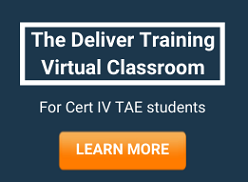About this unit.
This unit specifies the competency required to facilitate learning by individuals within a group.
The full Unit of Competency is available here.
Table of contents:
- Clarify the Purpose of the Learning Program
- Recognition of Prior Learning
- Clarifying Our Intentions
- WHS and Duty of Care
- Communicating for Learning
- Group Harmony
- Adult Learning Styles Influence the Learning Strategy
- Knowledge and Skills-Based Learning
- Learning Cues
- Writing a Session Plan
- Communicating for Learning
- Selecting Delivery Methods
- Engaging Presentation Skills
- Audio Visual Resources
- Facilitating Group Learning
- Reward Learning
- Communicating Verbally and Non-Verbally
- Use Language That Suits The Purpose
- Expect the Unexpected
- Managing Group Dynamics
- Delivery Record Keeping
- Reviewing the Program
This unit includes the following elements and performance criteria.
Element 1. Establish an environment conducive to group learning
1.1 The learning program and delivery plan are read and interpreted to identify and confirm delivery requirements for the specified session
1.2 Availability of all resource needs is confirmed prior to commencement of session/s
1.3 Outcomes of learner recognition processes are obtained from relevant persons to provide flexible responses to individual learner needs
1.4 The learning program/segment of the learning program is introduced and objectives, expectations and requirements including workplace health and safety (WHS) are discussed, clarified and agreed
1.5 A learning facilitation relationship is established between trainer/facilitator and the group using appropriate oral communication and language skills and interpersonal skills
1.6 Relationships with and between learners are initiated which support inclusivity, acknowledge diversity and enable a positive learning environment
Element 2. Deliver and facilitate training sessions
2.1 Interactions with learners are based on the application of learning principles in accordance with learner styles and identified learner characteristics
2.2 Each training session is conducted in accordance with session plans but modified where appropriate to meet the needs of the learners
2.3 All resource requirements for delivery are addressed and the diversity of the group is used as another resource to support learning
2.4 Generic skills relevant to the learning objectives are addressed in delivery
2.5 A range of delivery methods are employed and appropriate technology and equipment are used as training aids to optimise the learner experience
2.6 Opportunities for practice and formative assessment are built into the delivery, where assessment is required
Element 3. Demonstrate effective facilitation skills
3.1 Presentation skills are used to ensure the delivery is engaging and relevant
3.2 Group facilitation skills are used to ensure effective participation and group management
3.3 Oral communication and language skills are used to motivate the learner and to transfer knowledge and skills
3.4 Interpersonal skills are used to maintain appropriate relationships and ensure inclusivity
3.5 Observation skills are used to monitor individual and group progress
Element 4. Support and monitor learning
4.1 Learner progress is monitored and documented to ensure outcomes are being achieved and the needs of individual learners are being met
4.2 Adjustments are made to the delivery plan to reflect specific needs and circumstances and unanticipated situations
4.3 Learners are encouraged to reflect on personal learning progress
4.4 Group dynamics are managed to ensure effective participation by all learners and to maintain effective relationships
4.5 Inappropriate behaviour is managed using conflict resolution and negotiation skills to ensure learning can take place
4.6 Learner records are maintained, stored and secured in accordance with legal/organisational requirements
Element 5. Review and evaluate effectiveness of delivery
5.1 The delivery plan is evaluated to determine its effectiveness as a tool in guiding the learning process and feedback is provided to the writer, as appropriate
5.2 Feedback from learners/management/peers is sought on the quality of delivery, and areas for improvement are identified and documented
5.3 Trainer/facilitator reflects on own performance in training delivery
5.4 Areas of improvement/new ideas to improve the quality of delivery/facilitation and to enhance the learning experience are considered and implemented









